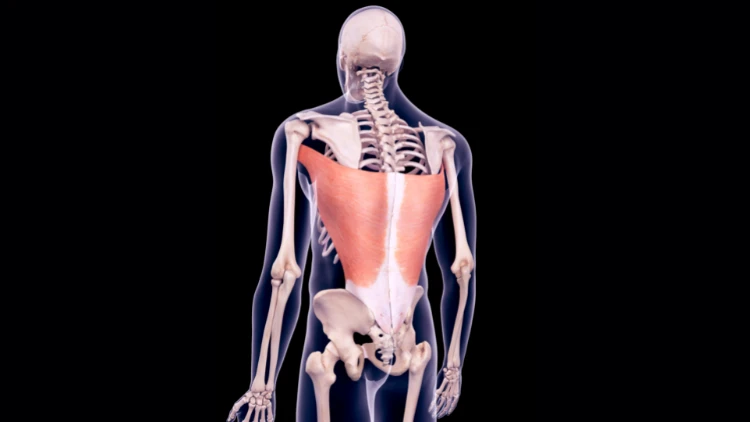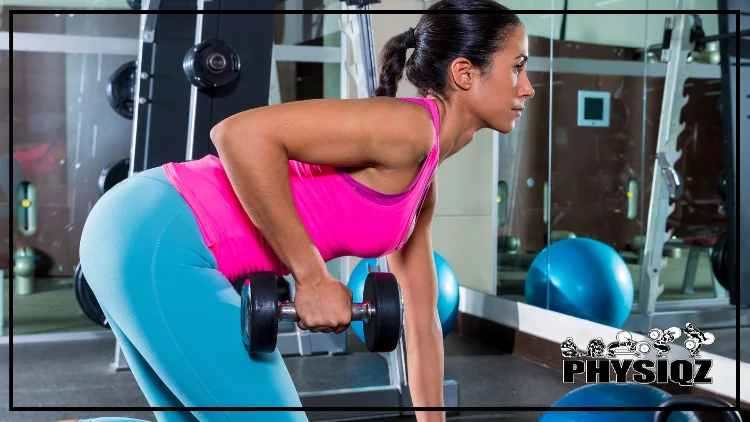
If you suffer from low back pain or a weak core, want increased flexibility, or simply want to build stronger muscles, then lower back exercises with dumbbells can be a great option.1
However, I do not personally do them and would suggest giving these workouts a second thought before delving in, as the lower back muscles get more than enough activation in other compound exercises such as deadlifts and good mornings.
Since dumbbell lower back exercises might still be used in certain situations or training regimens, let’s review some low back anatomy, dumbbell exercises as well as their risks and benefits to fully assess if they’re right for your training protocol.
Anatomy of Lower Back Muscles & Their Function
The lower back is composed of many various muscles, tendons, and ligaments that keep you mobile, flexible, stabilized, and help you bend in various directions. The anatomy of back muscles is extensive, but here we will focus mainly on lower back muscles.2
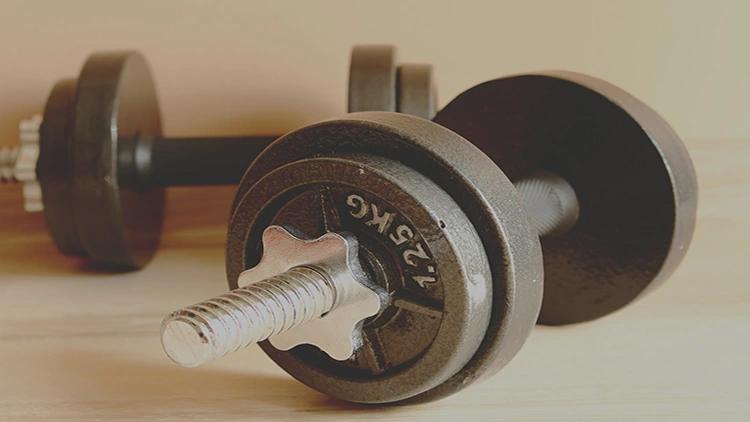
Source: noah1974 on Pixabay3
If you feel that your lower back or adjacent areas including the abdomen are weak or easily fatigued, you might want to strengthen the lower back muscles attached to your lumbar spine:
- Multifidus Spinae: This muscle is formed from many small fleshy bundles (fasciculus), triangular in shape and running along both sides of the spinal column. The multifidus spinae, or simply “multifidus”, functions to help stabilize the spine and trunk. Issues or dysfunction within the lower (lumbar) multifidus can contribute a great deal of lower back pain. If atrophying and unused, the multifidus muscles can even be replaced with fat. If you contract the pelvic floor muscles for several seconds at a time, you can strengthen these muscles and, in turn, strengthen your lower back.
- Erector Spinae (Spinal Erectors): The erector spinae is a group of both tendons and muscles spanning up and down the length of the back, along each side of the vertebral column as well, all the way from the sacral area in the lumbar region up to the base of your skull.4 The erector spinae is made up of three muscles: the spinalis muscles, longissimus muscles, and iliocostalis muscles. The erector spinae helps you rotate or straighten your back and works in tandem with the glutes to keep you upright and help your alignment when sitting and standing.
- Latissimus Dorsi (Lats): A large, flat muscle extending across the lower and middle back, these are commonly referred to as “lats” and reach all the way to your arms. Your lats allow you to bend side to side and to lift yourself up.
- Paraspinals: Another grouping of muscles that extend the length of the spine, your paraspinals help you maintain your alignment and help your spine bend, rotate, and extend as needed.
- Iliopsoas: Composed of three muscles, the iliopsoas provide flexibility and stabilization of the hips and lumbar spine while doing many movements or activities from standing to walking to running. You have one on each side of your spine.

Source: Science Photo Library via Canva.com5
While these are some specific muscles and muscle groups that play key roles in supporting your lumbar spine, four much more generalized but notable muscle groupings are:
- The extensor muscles, including the glutes and the erector spinae mentioned above, attach to the back side of the spine and allow you to lift items or simply stand up.
- The flexor muscles extend along the front of the spine and play a part in forward bends, arching the lumbar region (lower back), and lifting.
- Your oblique muscles are attached to each side of your spine, enabling rotation and helping with stability and upright alignment.
- The posterior chain refers to all muscles along the back of your body warm-up from your heels all the way up your calves and back to the back of your head (including calves, hamstrings, glutes, erector spinae muscles and others).
All in all, lower back muscles serve you by ensuring that your vertebrae and entire spinal column can rotate, stabilize, and flex seamlessly. It’s vital to strengthen and protect these muscles so your body continues working as it should, and muscle engagement in these areas play a major role in that.
Incorporating lower back exercises into a hypertrophy mass routine is a perfect way to work these in.
Top 11 Dumbbell Exercises for the Lower Back & How To Do Them
Using dumbbells in lower back workouts allows for a much more targeted exercise and for precise muscles to be worked instead of overall muscle groups.
Some of my favorite dumbbell exercises include the side hip raise, glute bridge, and the back hyperextensions, but let’s take a look at what other options we have and how to do them; just don’t forget to cycle out exercises each training cycle to ensure a well-rounded strength routine.
1. Dumbbell Deadlift
You may know some friends on rigorous powerlifting and powerbuilding programs who swear by dumbbell deadlifts for lower back strength; but what exactly is the dumbbell deadlift and how is it done?
Find an open area where you are able to move freely and set two dumbbells on the floor near your feet, one on each side. After placing your feet facing forward and hip-width apart, bend at the knees and reach down to grab these dumbbells with an overhand grip, one in each hand.
Sit deep, balancing as you keep your chest pointing forward and up, shoulder blades together, and core tight.
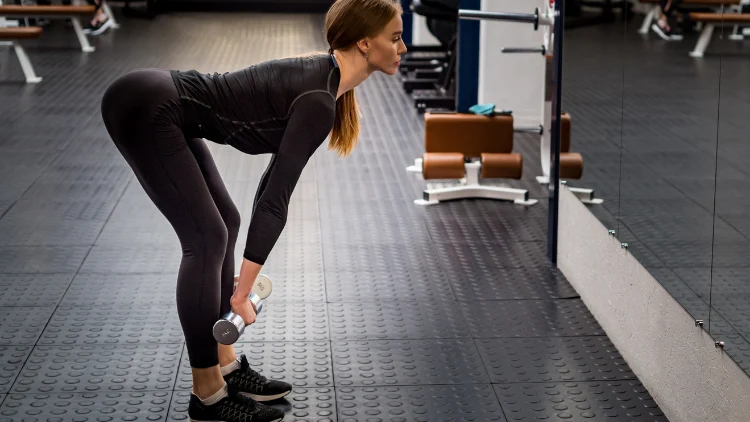
Source: Oskanov via Canva.com6
As you move back to a standing position, breathe out, keep shoulder blades pinched and core stabilized, and push your hips forward as you reach your normal standing stance. The dumbbells should fall naturally along your sides as you stand.
Continue several repetitions to practice your form until it becomes more natural and second-nature, remembering to inhale on the way down and exhale as you stand.
Start out with 3 sets of 6 reps and you can slowly work your way up from there, increasing the number of both sets and reps over time. For any exercise, starting out slow is best and safest so as to avoid injuring yourself or straining your muscles.
2. Superman With Dumbbells
This is a great dumbbell workout for lifters of all experience levels and can be done virtually anywhere, as long as you can lay down flat.
This workout will tone your core, lower back, glutes, and even incorporate some of the upper back, really giving you that burn that lets you know your muscles are engaged.
To perform the superman exercise with dumbbells, start by laying on your stomach with arms extended forward in front of your head, holding the barbells as they rest on the ground. To begin the exercise, tense your core and glutes as you raise your legs, arms, and chest off the ground.
Now, pull your shoulder blades back and together as if trying to touch them as you bend your arms at the elbow, pulling them back until your still-raised hands and dumbbells are alongside your shoulders. Continue keeping your arms, legs, and chest elevated and your heading facing down towards the floor throughout the entire set.
Start out with 3 sets of 8-12 repetitions for this workout routine. You may feel the burn in your delts, traps, erector spinae, and glute muscles as these are the areas worked in the superman position.
An alternative method of performing the superman with dumbbells is to keep your arms extended past your head in the starting position, and instead of pulling the dumbbells back towards your sides, simply raise your feet and arms slightly on each rep before bringing them back down to starting position (as portrayed in the video below).
3. Side Hip Raises With Dumbbells
The side hips raises are usually done without the added weight of dumbbells and target the abs and lower back but are also amazing for toning your glutes. With the help of dumbbells, you can expedite gains in both strength and muscle toning in these areas.
To get in starting position, lay on your side with the length from your hip to ankle touching the ground, propping your upper body up on one forearm. Hold the dumbbell on your opposite (above) hip in the other hand.
Using your core muscles, pull your hips off the ground to make a straight line from head to foot with your body, using your forearm and foot touching the ground for leverage.
As you lift your hips, also use your opposing arm to lift the dumbbell in a slow and controlled motion from hip level up until it is directly above your shoulder (as pictured below).
Try 10-15 reps on each side. Focus on controlled movements and proper form rather than speed.
4. Dumbbell Romanian Deadlift
As a variation on the deadlift, the Romanian deadlift is done with the dumbbells in front of you rather than to your sides and gives a very well-balanced workout throughout the entire posterior chain.
To get in starting position, stand with your feet shoulder length apart with your chest facing forward and your back arched slightly back for proper form. Dumbbells should hang fairly naturally in front of you near your thighs.
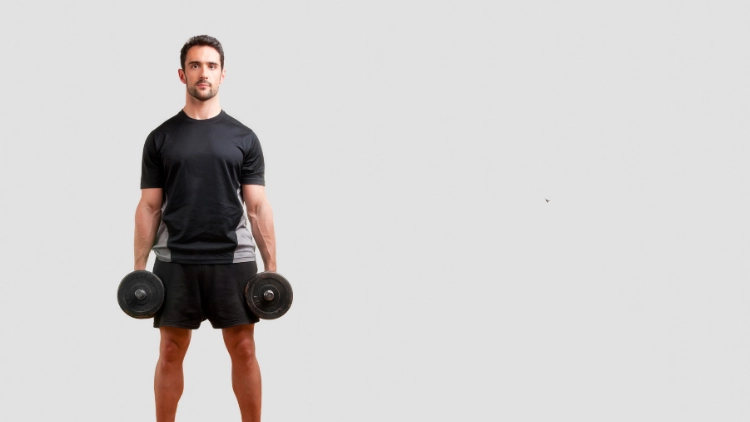
Source: ruigsantos via Canva.com7
Now, in a slow and controlled movement, bend your upper body forward but keep your legs straight instead of bending at the knee for this variation. As you perform this motion, inhale and continue warm-up your upper body, arms and the dumbbells down until they are at about shin level.
You do not need to reach the dumbbells all the way to touch the ground but you should be able to feel a gentle stretch in your hamstrings.
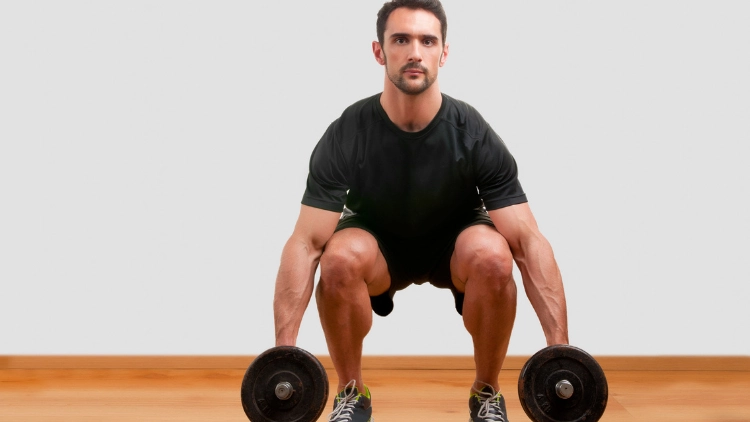
Source: ruigsantos via Canva.com7
Once at the low point of this motion, exhale and use your back, core, and glutes to pull you back up to the standing start position.
Try 3 sets of 8-12 reps and, as always, stop immediately if you feel any pain.
5. Bent Over Row With Dumbbells
Bent over rows commonly are used for upper back routines, but can also serve to strengthen your lower back as they really activate the lats, which stretch down towards the lower back and help provide control and stabilization to the lower body and torso.
For this next workout, you’ll start with your feet shoulder length apart and bend your torso forward from the hips without locking your knees. Instead, keep your knees slightly bent with the weights hanging down comfortably with your arms loose.
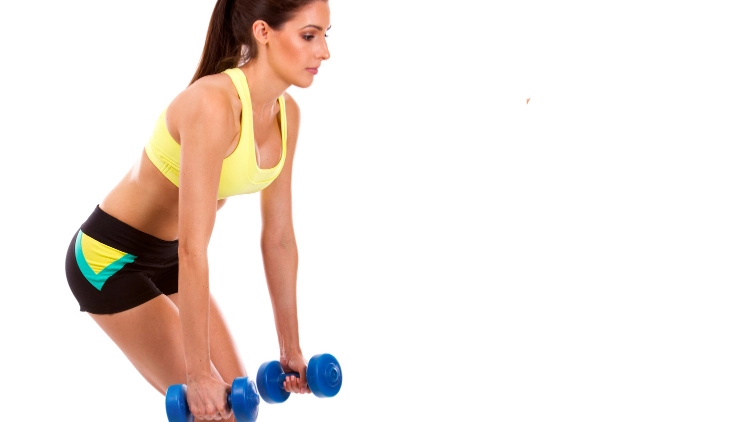
Source: zdenkam via Canva.com8
Next, squeeze your shoulder blades together and pull the weights up towards your waist by bending your arms at the elbows and then pulling your elbows back until the dumbbells are at each of your sides.
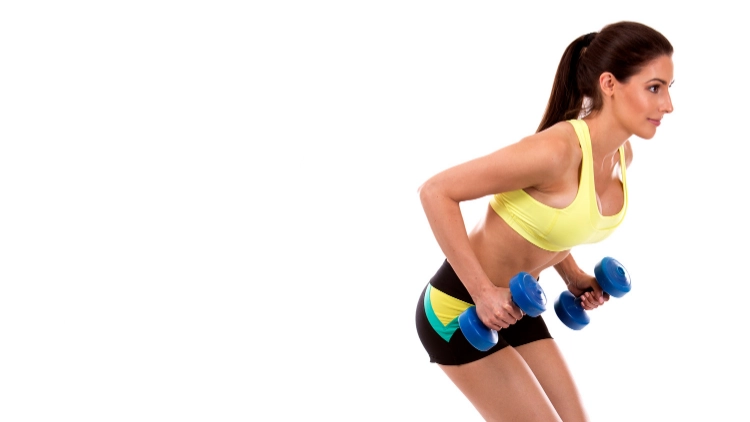
Source: zdenkam via Canva.com8
Lower the dumbbells back down to starting position and continue on like this for 3 sets of 8, raising the dumbbells in 1-2 seconds, holding for 1-2 seconds, and lowering for 1-2 seconds in each rep.
Note that you can also do this routine one arm at a time if preferred, and the arm you are not using for lifting can rest on a bench or other surface for leverage and support.
6. Glute Bridge With Dumbbells
The glute bridge muscles worked are mostly engaged in the glutes of course, but it also recruits plenty of other muscles including the hamstrings, abdominal muscles, and lower back muscles. This might be a good option for you if you suffer from lower back pain, as the glute bridge stance takes almost all the pressure off of the lower back.
Along the same line, this is a useful alternative to squats if you have pain or injuries that prevent you from doing those comfortably.
This exercise is very simple, only requires one dumbbell, and can be done virtually anywhere you can find a flat surface.
To perform the dumbbell glute bridge, begin by laying on your back with knees bent, pulling your feet up as close to your butt as possible (ideally about 6 inches away). Hold a dumbbell on your lower stomach with both hands.
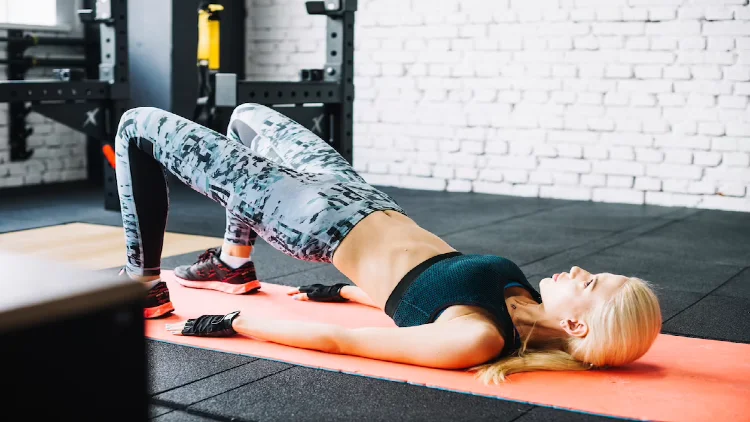
Image by Freepik9
Now, push down through the heels and thrust upwards with your hips, bringing your waist up to form a straight line from your neck through the core to your knees. Only your head, shoulders, and feet should be on the ground now.
Hold for a beat as you activate your glute and abdominal muscles.
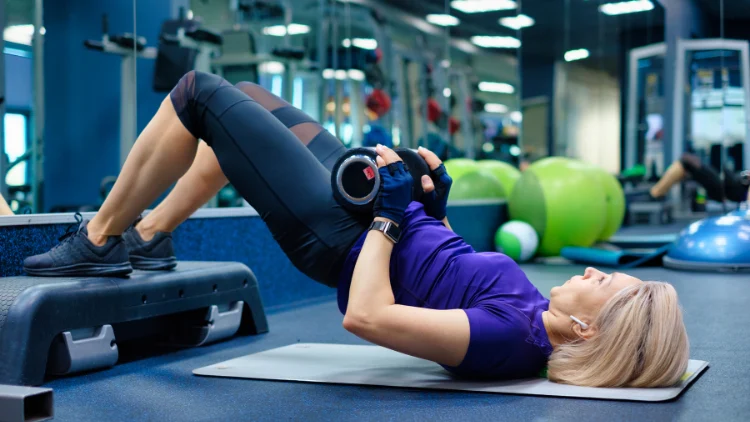
Source: avdeev007 via Canva.com10
2-3 sets of 10 reps should be good for beginners on this workout; remember to exhale on the way up and inhale on the way down, always using slow and controlled movements.
7. Stiff Legged (Straight Legged) Deadlift With Dumbbells
Ideal for strengthening the length of the posterior chain and providing another variation of our deadlift workouts, the stiff legged deadlift requires just that: keeping your legs stiff. However, do not completely lock your knees as this can cause injury; instead, keep a very slight bend.
With your feet shoulder-width apart, keep legs straight without locking and bend at the hips until your back is parallel to the ground, then pick up one dumbbell in each hand with an overhand grip.
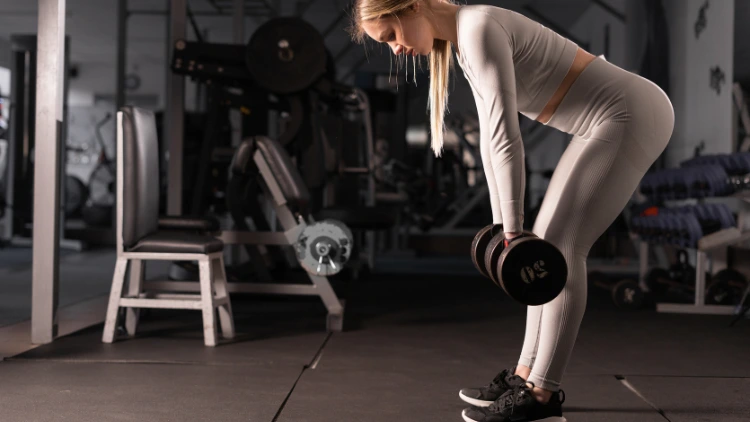
Source: Изображения пользователя Andrii via Canva.com11
Now, tightening the glutes, lift your torso back to an upright standing position with the weights ending up at your hips. Remember, in each of these exercises, speed is never the goal; rather, slow and steady movements with proper form are the priority.
Do not let your lower back round at all. Press your hips forward as you stand and be sure to keep your back straight and stiff throughout each motion.
3 sets of 8 reps are a good starting point for dumbbell straight leg deadlifts.
8. Dumbbell Good Morning
A very popular exercise, good mornings are amazing for glutes, the erector spinae, hamstrings, and lower back. With dumbbells added into the mix, these muscles will get an even better and more intense workout.
Starting with your feet hip-width apart and a dumbbell in each hand, lift the dumbbells so one rests on each shoulder.
Next, push back through your hips until your torso and back are nearly parallel to the floor, engaging your core for stability.
Hold for 1-2 seconds, then return to your starting position by pushing forward through your hips.
Tips:
- Create movement by pushing through the hips rather than dropping or lifting your torso
- Keep your spine arched just slightly, squeezing shoulder blades together
- Good mornings can be done at the intermediate and expert levels with a barbell or even seated, but beginners should start with dumbbells
9. Back Hyperextensions With Dumbbells
Performed on a hyperextension machine, this particular exercise is one that will need to be done in the gym and isn’t quite as “mobile” as others unless you happen to have one in your home gym.
However, it is important to incorporate this exercise into your routine when possible because it really emphasizes the entire lower back and erector spinae muscles, helping with flexibility and support.
Position yourself as pictured on the hyperextension machine, holding one dumbbell with both hands at chest level and with your hips pressed firmly against the top of the machine’s padding.
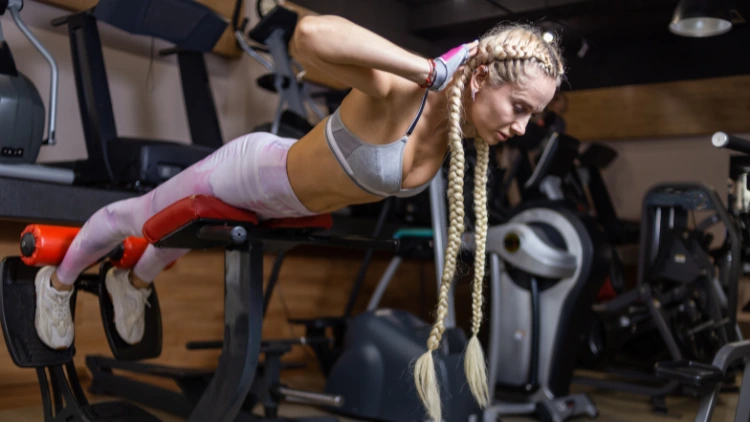
Source: vladimirsukhachev via Canva.com12
Bending at the hips just above the pad, slowly lower your upper body, keeping your torso stiff and core muscles engaged.
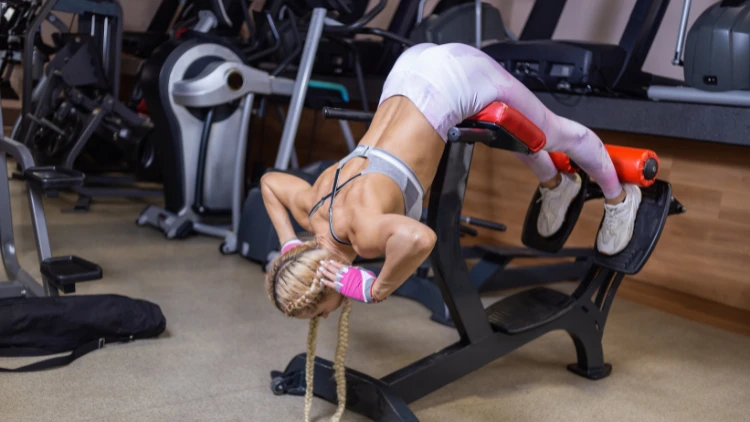
Source: vladimirsukhachev via Canva.com13
Hold this position momentarily before returning to the first position.
Try 2-4 sets of 8 repetitions on the hyperextension machine.
10. Bird Dog Rows With Dumbbells
Bird dog rows provide incredible activation throughout the glutes, erector spinae muscles, and rectus abdominis and can improve your alignment, balance, and flexibility. It’s great for improving core stability and overall lower back strength, as it makes your body struggle to maintain control.
For single arm bird dog rows, begin by getting on all fours on a bench, left hand either gripping the side of the bench or palm down on the bench for stability. The dumbbell can start on the bench just to the right of your left hand.
Grasp it with an overhand grip in your right hand. Then, lift your opposite (left, in this case) leg straight back and pick up the dumbbell in your right hand.
You’ll instantly feel your core activate to try to maintain balance.
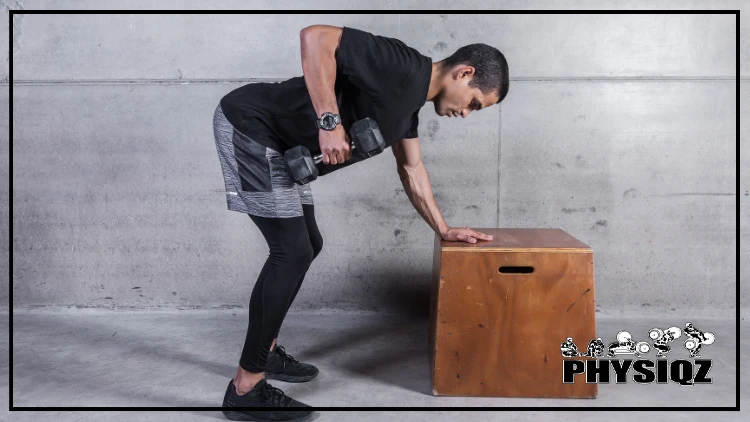
Source: Juan_Algar via Canva.com14
Lift the dumbbell up to your side by bending your right arm at the elbow, then hold for a second or two before lowering the dumbbell not back to starting position but alongside the side of the bench. This is one rep.
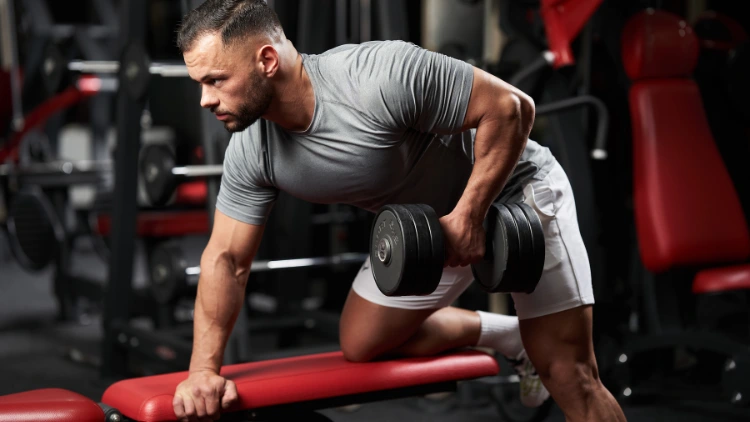
Source: Slatan via Canva.com15
Aim for 3 sets of 6 reps on each side. Reverse instructions for the left side bird dog row (always lift your opposing leg).
11. Renegade Rows With Dumbbells
This exercise is extremely dynamic as it targets your full body including your core muscles, arms, and both upper and lower back, as the lats are recruited and can help with lower back stabilization or strengthening. With correct form, you should also be able to improve balance.
For renegade rows, you’ll place one dumbbell under each shoulder, get in the plank position, and grasp each dumbbell in one hand with an overhand grip. Place your feet hip to shoulder width apart; only the dumbbells and the balls of your feet should be touching the ground.
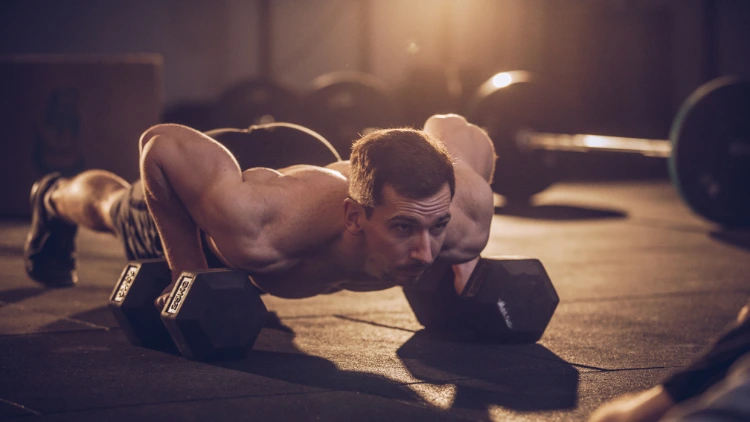
Source: South_agency via Canva.com16
Engaging your core and glutes, bring one dumbbell at a time up to your side in a very slow and methodical movement. Do not let the dumbbell swing wide; instead, bring it up close to your chest, being careful not to open up your chest but keep it facing down.
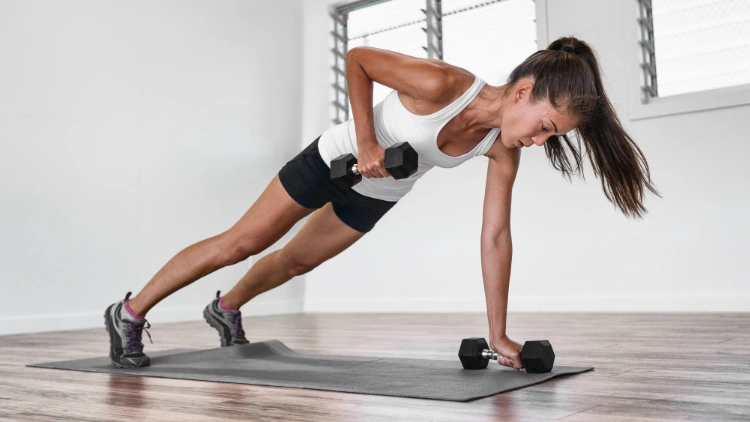
Source: Maridav via Canva.com17
You shouldn’t need to rotate your hips, open the chest, make wide swings with the dumbbells, or use momentum to keep this movement going. If you do, try starting with a lower weight first and working your way up.
Tips:
- Use a motion like starting a push lawn mower to lift the weights along each side
- A wider base or stance makes this easier, so adjust your feet to shoulder width if needed
- To eventually scale this exercise up, you can either try elevating your feet during the workout or go narrower with your base
Beginners should try for 3 sets of 8 reps on each side.
Benefits of Lower Back Exercises
The benefits of lower back exercises with dumbbells or without abound. Strength training your lumbar region or focusing on unilateral targeted exercises can even improve quality of life for you or anyone with chronic or acute lower back pain.
You might be relieved to hear that you can train for core stability to prevent injuries and strengthen your entire trunk and core through lifting, but be sure to have proper powerlifting gear and equipment.18
Just a few of the many benefits of lower back exercises include:
- Stronger abdominal muscles
- Increased flexibility
- Greater range of motion
- Increased flexibility
- Stronger core
- Better balance
- Improved alignment
- Injury prevention
- Greater stability and control
- Decreased lower back pain
- Less discomfort
How Fortifying the Lower Back Muscles Improves Flexibility & Alignment
A weak lower back can cause endless pain and discomfort throughout the entire musculoskeletal system, as the lower back is a focal point of the body and is connected to so many other areas. A weak, unstable, or painful lower back is not something you want to mess with as it can cause chronic or even lifelong issues.
Though this may come as a surprise to you, abdominal and core stability are closely related to the muscles in the lumbar region, as are the glutes and hamstrings.
With so many vital muscle groups being connected, you can see how abnormal alignment might reduce balance in the trunk area, boosting likelihood of lower back pain.19
The lumbar portion of the back carries a lot of body weight compared to the middle and upper back and is the most flexible part as well, making injuries and pain even more common.
Lower back pain causes alignment and musculoskeletal abnormalities to the extent that people with a history of lower back pain activate different muscles and use different movements to maintain balance than those without.20
As this portion of your body works to stabilize the spine and to help with upright alignment when sitting or standing, dumbbell exercises for the lower back can help strengthen these areas and prevent such issues from arising.
The Importance of Warm-Up
I cannot emphasize the importance of warm-up enough, as warm-up not only increases flexibility, but plays a necessary role in maintaining or gaining flexibility, preventing injuries, allowing for hip and back movements and extended range of motion.
Dynamic warm-up before and after workouts is often said to be crucial to peak performance without muscle tears, strains, or injuries.
But for those with pre-existing lower back pain, pain can be exacerbated and even flexibility reduced by over warm-up sore muscles. As you can see, this can go either way, so be sure you are warm-up the right muscles and perhaps even consult a PT if unsure.
Benefits of a Strong Lower Back
Ask anyone who has a lower back injury or stiffness and I’m sure they’ll tell you not to take a strong and healthy lower back for granted. A strong lower back can be achieved through targeted exercises, compound movements, powerlifting, and other workouts and stretches.
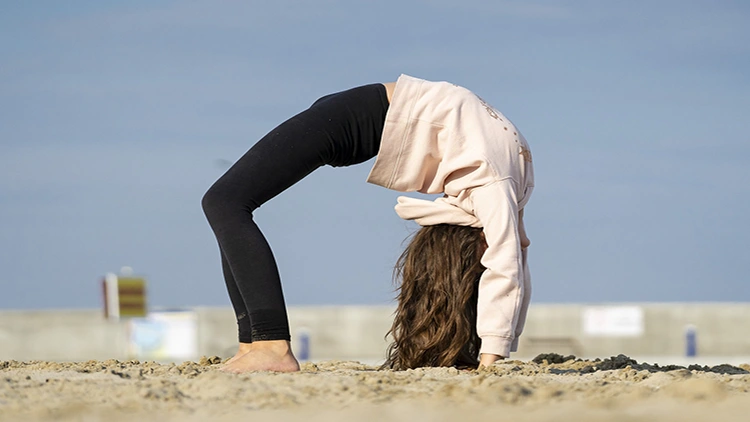
Source: Anestiev on Pixabay21
This strengthening of your back will:
- Decrease chance of injury or unnecessary tenderness
- Give you added muscle control
- Stabilize your spine
- Improve your alignment
- Increase stability
- Improve balance
How To Maintain Back Strength
Back strength can be achieved through the exercises mentioned above, but what if you are at the point that you’re just trying to maintain?
If you’ve tried powerlifting programs for beginners or powerlifting programs for intermediate lifters but are in need of slowing down the pace to focus on maintenance for now, you can focus on volume landmarks for muscle growth to determine the minimums you must achieve to maintain that muscle.
Research and utilize hypertrophy back training tips and volume landmarks whether you’re trying to increase muscle mass or strength.22 These landmarks can give you a baseline or range of how many sets and reps should be completed to simply maintain your back strength, or what you should achieve to gain muscle.
For example, the maintenance volume needed to maintain your current back strength is approximately 6 sets each week and should consist of both horizontal and vertical pulling exercises. While 6 sets could be completed in one workout, we advise splitting these 6 sets between 2-3 sessions throughout the week.
Of course for muscle growth, you’ll need to increase sets beyond the bare minimum for maintenance; shoot for 10-12 weekly sets for growth.
Additionally, you should ensure you’re eating foods high in protein, staying hydrated, and continuing to keep your body agile and flexible with daily exercises and stretches if able. Other factors you should consider are following a flexibility routine or doing hip exercises, such as the top 10 mobility moves to fix your knee, back, hip, and groin pain, as well as exercises for strong and supple hips, since the lower back is an integral part of movement and hip flexibility.
Why I Don’t Do Lower Back Exercises With Dumbbells
Now that I’ve described in depth nearly a dozen types of lower back exercises with dumbbells and how to do them, you’ll likely be shocked to find out that I don’t do them–and I don’t recommend that you do them either; let me explain why not.
The lower back reaches the point of fatigue even on compound movements that use various muscle groups, so I don’t find that dumbbells are needed in exercises that highly target the lower back.
The lumbar region already gets more than enough volume without being directly worked over.
In very rare and certain situations, someone may want to give hyper-focused attention to one of these lower back muscles but this should not be common and can cause more harm than good if overdone. Similarly, training trap muscles specifically is overdoing it and can be a waste of time since lateral shoulder movements give your traps more than enough of a workout.
In support of this concept is the fact that spinal loads during heavy deadlifts can lead to fractures, worsening back pain, and even degeneration, especially with frequent repetition.23
Instead of using dumbbells, each of the 11 workouts we went over can be done with your body alone or you can focus on other compound movements completely as long as they do incorporate the lower back.
Bodyweight exercises are plenty for the lower back and provide these muscles with more than enough resistance, so the added weight of dumbbells is not needed and can even cause or exacerbate existing back pain.
Take heart in knowing that spinal instability can cause low back pain, but full engagement of core muscles can increase stability and strengthen these muscles.24
Lower back pain, whether acute or chronic, is one of the most common reasons cited for doctor’s visits, missed days of work, and the need for physical therapy.
I cannot reiterate the importance of lower back strength enough; you may want to consider a starting strength routine and building strength and muscle to avoid weakness or injury.
While lower back exercises with dumbbells are not recommended, compound bodyweight exercises can do wonders for you.
Frequently Asked Questions
Are Dumbbells the Best for Strengthening Your Lower Back?
Dumbbells can be a useful tool for many routines, but should not be used to work the lower back muscles as they can put too much added weight and strain on already easy to injure muscles. Use compound movements and your own bodyweight instead.
What Lower Back Workouts Can Be Done at Home?
Almost all lower back workouts can be completed at home with the right equipment. Thankfully, lower back workouts do not necessarily need added weight or expensive weights and tons of equipment, as strengthening your lower back can be done with your body alone (stretches, pelvic floor exercises, glute bridges, side hip raises, etc.)
What Are the Top 3 Workout Routines for a Painful Lower Back?
Three fantastic workout routines I haven’t mentioned yet that can help you if you have a sore or tender back are swimming, yoga (the “child’s pose” is great for lower back pain), and knee to chest stretches.
Can Lower Back Exercises With Dumbbells Be Done With Kettlebells Instead?
While kettlebells can replace dumbbells in many strength routines, neither are recommended for lower back workouts as added weight is not needed to sufficiently hit the lumbar muscles.
References
1lunamarina. Canva. Accessed 21 April 2023. <https://www.canva.com/photos/MABB0Vgrhl4-girl-one-arm-dumbbell-bent-over-row-workout/>
2Henson, B., Kadiyala, B., & Edens, M. (2022, August 25). Anatomy, Back, Muscles. National Institute of Health. Retrieved January 13, 2023, from <https://www.ncbi.nlm.nih.gov/books/NBK537074/>
3“Weightlifting Barbells Dumbbells – Free photo on Pixabay.” Pixabay, 24 January 2018. Accessed 21 April 2023. <https://pixabay.com/photos/weightlifting-barbells-dumbbells-3102641/>
4Harvard University. (2023). Erector Spinae Muscle Forces. Harvard Natural Sciences Lecture Demonstrations. Retrieved January 19, 2023, from <https://sciencedemonstrations.fas.harvard.edu/presentations/erector-spinae-muscle-forces>
5Science Photo Library. “F017/1255.” Canva. Accessed 12 April 2023. <https://www.canva.com/photos/MADq3vbyn-k-f017-1255/>
6Oskanov. Canva. Accessed 21 April 2023. <https://www.canva.com/photos/MAD240wcvmU-beautiful-woman-performs-romanian-deadlift-in-gym/>
7ruigsantos. Canva. Accessed 21 April 2023. <https://www.canva.com/photos/MAC922fyEEo-dumbbell-squat/>
8zdenkam. Canva. Accessed 21 April 2023. <https://www.canva.com/photos/MADBZRGFGok-bent-over-rows/>
9“Free Photo | Pretty woman lifting hips.” Freepik. Accessed 21 April 2023. <https://www.freepik.com/free-photo/pretty-woman-lifting-hips_1367704.htm>
10avdeev007. Canva. Accessed 21 April 2023. <https://www.canva.com/photos/MAEJC1rwid8-hip-thrust/>
11Изображения пользователя Andrii. Canva. Accessed 21 April 2023. <https://www.canva.com/photos/MAFbH0iFg74>
12vladimirsukhachev. Canva. Accessed 21 April 2023. <https://www.canva.com/photos/MAFGoLHveW0-young-fit-blonde-woman-with-long-pigtails-doing-hyperextension-i/>
13vladimirsukhachev. Canva. Accessed 21 April 2023. <https://www.canva.com/photos/MAFGoFKvuog-young-fit-blonde-woman-with-long-pigtails-doing-hyperextension-i/>
14Juan_Algar. Canva. Accessed 21 April 2023. <https://www.canva.com/photos/MADRbwEah2E-sportsman-doing-dumbbell-row/>
15Slatan. Canva. Accessed 21 April 2023. <https://www.canva.com/photos/MAEiPzN_gqs-man-doing-dumbbell-row-workout/>
16South_agency. Canva. Accessed 21 April 2023. <https://www.canva.com/photos/MAEJRFhQY8I-push-ups-on-dumbbells/>
17Maridav. Canva. Accessed 21 April 2023. <https://www.canva.com/photos/MAD6CHTZxNo-woman-working-out-alone/>
18Bliven, K., & Anderson, B. (2013, November). Core Stability Training for Injury Prevention. National Institute of Health. Retrieved January 13, 2023, from <https://www.ncbi.nlm.nih.gov/pmc/articles/PMC3806175/>
19Paek, S., Kang, J., Shin, B., Jung, J., Rim, H., Yun, M., Lee, K., Yoo, Y., Hong, B., Lim, S., & Kim, J. (2022, December 6). Changes in Trunk Muscle Activity during Unilateral Weight Bearing and Abnormal Postural Gait in Healthy Individuals. National Institute of Health. Retrieved January 13, 2023, from <https://pubmed.ncbi.nlm.nih.gov/36557001/>
20Sperry, M., Phillips, A., & McGregor, A. (2019). Lower back pain and healthy subjects exhibit distinct lower limb perturbation response strategies: A preliminary study. National Institute of Health. Retrieved January 13, 2023, from <https://pubmed.ncbi.nlm.nih.gov/30056411/>
21Anestev, Christo. “Girl Yoga Flexibility – Free photo on Pixabay.” Pixabay, 16 March 2021. Accessed 21 April 2023. <https://pixabay.com/photos/girl-yoga-flexibility-happy-beach-6096186/>
22Israetel, M. (2019, November 25). Back Growth Training Tips. RP Strength. Retrieved January 19, 2023, from <https://rpstrength.com/back-training-tips-hypertrophy/>
23Ramirez, V., Ghezelbash, F., Shirazi-Adl, A., & Bazrgari, B. (2023, January 6). Trunk Muscle Forces and Spinal Loads During Heavy Deadlift: Effects of Personalization, Muscle Wrapping, Muscle Lever Arm, and Lumbopelvic Rhythm. National Institute of Health. Retrieved January 13, 2023, from <https://pubmed.ncbi.nlm.nih.gov/36606738/>
24Harvard Medical School. (2020, August 1). Three moves for better spine health. Harvard Health Publishing. Retrieved January 13, 2023, from <https://www.health.harvard.edu/staying-healthy/three-moves-for-better-spine-health>
